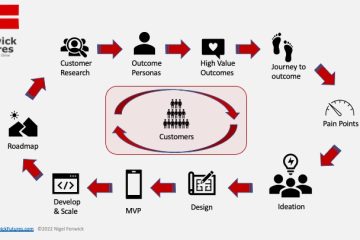Disruptive Ideation
(Continued from Step 3 – Overlay perceived value gained and lost).
This is the stage where all the customer research we’ve done begins to pay off. In my workshops, teams must learn to unleash their creativity. But that’s not as easy as it sounds.
Focus Ideas on Outcomes Of Value
Using the opportunities identified in steps two and three, teams come up with as many ideas as possible for using technology to help get the customer persona to the outcome identified in step 1. This could be a new mobile app designed specifically around overcoming losses of value in the existing journey to the outcome, or it could be a series of new services supported by digital capabilities. Or a new digital product. The possibilities are limited only by the imagination.
Rank The Potential Solutions
Once you have a handful of ideas (opportunities), the next step is to narrow down the options based upon a combination of feasibility/viability and the value created for the customer.
There are likely to be some outlier ideas that deliver only incremental customer value while carrying high risk of failure because of the complexity of the solution. Rank these ideas lower.
The opportunities that generate the most potential customer value should be weighted higher, even if they initially appear difficult to execute. One of the biggest challenges I’ve found in leading workshops with executives in large companies is tied to perceived feasibility. Many good executives automatically examine ideas and begin to figure out how difficult or easy it would be to execute the concept. Their challenge is that they default to examining the idea in the context of their existing company, with all its resource constraints and budget challenges. The result: great ideas are jettisoned too soon.
When I see a team struggling in this way, I’ll challenge them to think of themselves as a four-person startup looking to bring the concept to market: What resources would they need? What partners could they work with? How could they test their concept? This approach frees the team from the mental barriers imposed by their organizational experience.
Identify Needed Capabilities
To execute the new product concept, the team must identify all the business and technology capabilities it will need. This means internal and external partners as well as technology platforms. It may be the team will need a strong technology partner to help design and build the product concept. Perhaps they need a research partner to validate initial assumptions. Maybe even a launch partner to help bring the product to market.
Identify The Revenue Model
Finally, the team should consider the revenue model (assuming a for-profit org). How will the product generate revenue for the organization? Will it be a subscription model? Or will the new product augment and increase sales of an existing product in the company’s portfolio? If so, how will the cost of this new product impact the margins of the existing product – for example will it increase or decrease the cost of sale?
Next steps:
As an analyst, I’ve published many reports on best practices derived from some of the world’s leading software companies. To learn more about digital product development, I encourage you to read Marty Cagan’s insightful book “Inspired”. Develop the product concepts through a series of iterative stages that include: (See figure)
- Research to validate assumptions
- Design and test a product prototype
- Develop, launch and scale the minimum viable product (MVP)
- Collect customer feedback and usage analytics
- Develop the forward product roadmap
- Continuously improve the product

Other posts in this series:
- Introduction: How To Design Digital Products Customers Love
- Step one: understand your customer.
- Step two: Create an outcome journey map.
- Step three: Overlay perceived value gained and lost.

0 Comments